Attack Of The Cicadas 2024 Map, FAQ And Tips
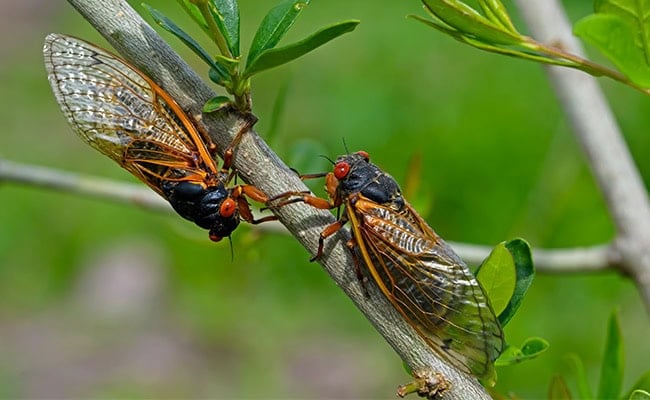
Many news outlets are talking about the trillions of cicadas due to emerge in April 2024—a rare “double brood” event that hasn’t happened in two hundred years. But what does this mean for your gardens, how many US states will be affected, and—most importantly—how can you minimize the deafening noise that these creatures create? Here’s everything you need to know, including the Farmers’ Almanac Cicadas 2024 map, frequently asked questions, cicada meaning and superstitions—as well as essential tips for keeping your spring and summer days sizzling with the sounds of barbecues and not uninvited bug guests! This article includes expert advice and exclusive quotes from leading scientists Dr. John Cooley and Dr. Gene Kritsky.
Cicadas 2024 FAQ
What are cicadas?
Cicadas are large insects known for two things: their incredible buzzing song and their fascinating life cycle. Imagine a bug that spends years underground as a nymph, quietly sipping on tree sap through a straw-like mouthpart. When soil temperatures reach 64 degrees Fahrenheit, they emerge in a massive wave, transforming into big-eyed, winged adults.
Their loud song, produced by vibrating special organs in their abdomen, is their way of attracting mates. After a short, above-ground party (usually about four to six weeks), they lay eggs and the cycle starts anew.
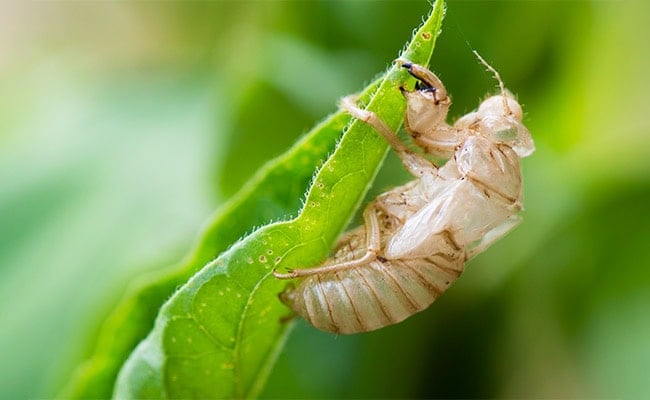
There are many different types of cicadas, ones with life cycles that overlap and appear to come out every summer and others that stay underground for several years before emerging in the spring. There are over 3,000 species of cicadas around the world. 190 species are in North America.
Annual cicadas are also called “dog day” cicadas because you often hear their high-pitched buzzing from June to August, during the Dog Days of summer. Other species, known as “periodical,” stay underground for long periods of time (either 13 or 17 years).
Are cicadas and locusts the same thing?
No, cicadas and locusts are two different bugs. Cicadas are larger than locusts. Yet, interestingly, American colonists often referred to cicadas as locusts and this misidentification persists today—especially for talking about periodical cicadas.
Jump to cicada meaning and symbolism
What makes the cicadas 2024 “double brood” event rare?
As soil temperatures begin to rise in spring 2024, two neighboring broods of periodical cicadas in the United States Midwest will emerge around the same time: Brood XIX (19), which appears every 13 years, and Brood XIII (13), which emerges every 17 years. This rare “double brood” event only happens about every two hundred years! The last time that Brood XIX and XIII emerged at the same time was in 1803. However the last time that 13-year and 17-year periodical cicadas emerged during the same year was in 1998.
Additionally, 2024 marks a special year for cicadas as all seven named species of periodical cicadas will be visible as adults this year, according to the University of Connecticut.
How many cicadas, really?
Trillions of cicadas are expected to emerge in 2024. Some estimates suggest millions per acre in some places! The highest densities will be in wooded areas, but cicadas travel far and wide into suburban and urban environments.
When will the two broods emerge?
Brood XIX and XIII are expected to emerge at some point in spring, depending on soil temperatures. Cicadas usually wait for temperatures to be consistent for about five days before making their way out. Associate Professor in residence at University of Connecticut Dr. John Cooley says, ” whenever the trees are just about leafed out, that’s when the cicadas emerge.”
Related: Phenology: How To Plant Using Signs From Nature
According to the Farmers’ Almanac Spring Weather Forecast 2024, the double brood may emerge in mid-April, when temperatures are expected to be unseasonably warm and rainy. Though they may wait until mid-May, which would be more customary.
Use the Farmers’ Almanac Long-Range Weather Forecast to make your own predictions!
Which US states will experience the double brood?
Brood XIII will appear in states like Iowa, Wisconsin, and possibly Michigan, while Brood XIX will emerge in states such as Alabama, Georgia, Kentucky, and Tennessee. See our Cicadas 2024 Map:
Despite many erroneous claims, the two broods will most likely not overlap. Though there is a chance they will in small patches of woodland around Springfield, Illinois.
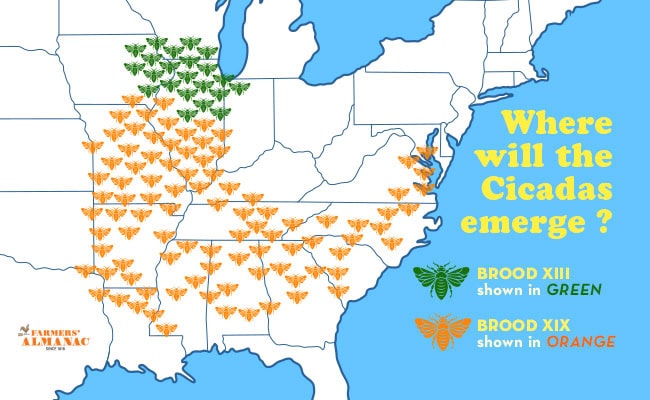
Two broods of periodical cicadas will emerge in 2024.
What do cicadas sound like?
The loud hum of cicadas mating sound may be as loud as 100 decibels, which is similar to the noise of a motorcycle revving or loud outdoor power tools. Interestingly, the sound of lawnmowers attracts these insects. For this reason, we recommend going lawn work early in the morning or late at night, when cicadas are less active. (See more tips for reducing noise below.)
Here is what Brood XIII sounded like the last time they emerged in Illinois:
Do cicadas “sing” at night?
In most cases, cicadas do not make noise after the Sun goes down. When you hear insects at night, they are most likely crickets or katydids. However, there are a few cases when cicadas may sing at night: bright lights like streetlamps, very hot weather, or if they’re feeling crowded or disturbed. There is also a chance that a bright full Moon may be perceived as dawn.
Are cicadas pests?
Despite their overwhelming numbers and loud mating calls, cicadas are harmless to humans and beneficial to local ecology. Though they are often considered to be pests, cicadas serve as a nutritious food source for birds. They even enrich the soil!
Related: Gardening By The Moon Calendar
Can cicadas bite you?
Cicadas will not bite you. If one happens to fly towards you, chances are it’s mistaking your arm for a tree branch. Don’t fret! Their feet are designed for gripping bark, so the sensation might feel a little strange, but they won’t bite. Just gently nudge them away and they’ll be on their way.
Will cicadas harm your gardens? How about your trees?
Good news! Cicadas won’t destroy your gardens. The only damage they may cause is “flagging” (cutting small v-shapes into) leaves when they lay their eggs. This won’t hurt mature trees “is a natural pruning … that results in more flowers and fruit the following year,” says Dr. Gene Kritsky, Professor Emeritus of Biology at Mount St. Joseph University.
But flagging isn’t good for the development of saplings. So we don’t recommend planting any new fruit trees or bushes if your state is indicated on our Cicada 2024 map. However if you would like to protect recently planted raspberry bushes for instance, you may cover them with netting. (Make sure that the holes in the netting are smaller than one centimeter wide.)
Are cicadas natural fertilizers?
Yes, when cicadas decompose, they add nutrients to the soil. Sodium, potassium, magnesium, calcium. But rather than scooping them into your gardens, Dr. Kritsky, says to “let the cicadas decompose around their trees. The nutrients would then be helpful to the trees where the cicadas can return the nutrients they obtained from the trees.
Related: Natural Garden Fertilizers
Can you eat cicadas?
Cicadas, traditionally eaten by Indigenous Australians, people from New Guinea, the Siamese, and Native Americans, were once highly valued as a special food in ancient Greece, Rome, and even today in Japan. Famous for being full of protein and clean for eating, cicadas only eat plant material, making them a healthy option for food.
Some compare cicadas to shrimp because they’re packed with protein and low in fat, similar to crickets, which are eaten all around the world. Even pets like dogs, creatures like squirrels, and other animals enjoy these insects as treats, while people with a taste for trying new foods experiment with their cooking possibilities. When cooked, cicadas are said to remind people of shrimp, asparagus, nuts, or popcorn, as reported by NBC.
If you’re thinking about trying cicadas as a new food idea, it’s better to choose the younger ones instead of the ones with tougher shells. But, it’s important to consider some health tips before you eat them.
Learn more about how to add cicadas to your meals: Download the PDF of recipes
Cicada Noise Tips
Whether your states is affected by the double broods or not, you may be wondering how to reduce the sound of these bugs.
- Minimize daytime lawn equipment use: While the jury’s out on how much this truly attracts cicadas, reducing noise during peak cicada hours can’t hurt. Enjoy the peace and quiet while letting your lawn grow a bit higher during this temporary event.
- Strategic watering: A strong hose can disrupt cicada activity and knock them off trees. Keeping your lawn hydrated may also offer some deterrence.
- Netting for vulnerable plants: Cover valuable shrubs and young trees with netting with holes smaller than 1 cm to prevent egg-laying.
- White noise for indoor relief: If the noise is bothersome indoors, consider using a white noise machine to help mask the soundscape.
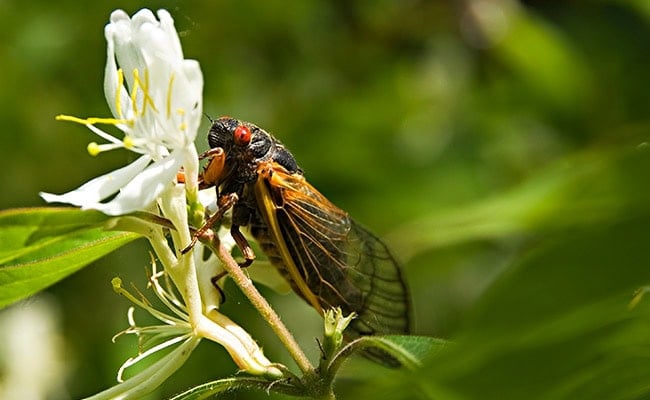
Cicada Meaning And Symbolism
Cicada meaning and symbolism spans the globe and has a rich history in ancient cultures.
- Ancient Greece & Rome: Cicadas were seen as symbols of rebirth and renewal due to their long underground life followed by a brief, winged adult stage. They were associated with Apollo, the god of music, poetry, and prophecy, due to their loud song.
- China: Dating back to 1500 BCE, cicadas were linked to immortality. Carved jade cicadas were placed on the tongues of the deceased, symbolizing a similar transformation and afterlife.
- Native American tribes: Some tribes viewed cicadas as messengers or prophets, their songs interpreted as warnings or forecasts. Speaking of forecasts … Get your long-range weather forecast here!
- Locust Misidentification: Early American colonists, unfamiliar with cicadas, often confused them with locusts, which are known for devastation (noted in the Bible and other texts). This likely led to some negative associations with cicadas, despite their ecological role. Dr. Kritsky underscores that “cicadas are not a sign of filth. They do not sting or spread disease.” He adds, “These emergences are a once in a generation event in many locations. These will make memories that people will remember 17 or 13 years in the future.”
In Western culture, cicadas symbolize various themes and ideas across different folklore traditions. Here are 6 examples:
1. Resurrection and Immortality: Cicadas spend years underground before emerging together. Cicadas’ life cycle has led to associations with resurrection and immortality in some cultures. The idea of emerging from the earth after a long period of dormancy can symbolize renewal and the eternal cycle of life.
2. Transformation and Change: The metamorphosis of cicadas from nymphs to adults symbolizes transformation and change. This symbolism is often associated with personal growth, spiritual awakening, and the cyclical nature of life’s phases.
3. Summer and Heat: Cicadas are creatures of the summer months, and their loud buzzing calls are often heard during hot, sunny days. As such, they can symbolize the intensity of summer heat and the passage of time during the warmer months.
4. Persistence and Endurance: Cicadas endure long periods underground, waiting for the right time to emerge. This persistence and endurance in the face of challenges can symbolize resilience, patience, and determination in folklore.
5. Joy and Celebration: In some cultures, cicadas are seen as harbingers of summer and symbols of joy and celebration. Their emergence coincides with warmer weather and the abundance of life in nature, making them symbols of vitality and happiness.
6. Loudness and Expression: The loud buzzing sound of cicadas can symbolize the power of expression and vocalization. In some folklore traditions, their calls are associated with communication, music, and the power of voice.
Overall, cicadas hold rich symbolic meaning in Western folklore, representing themes of transformation, resilience, joy, and the passage of time in various cultural contexts.
5 reasons to appreciate the “Cicadas 2024” event:
1. Rare Phenomenon: It’s unusual for two broods to emerge simultaneously. This rarity could attract the attention of scientists, entomologists, nature enthusiasts, and the general public interested in natural phenomena.
2. Ecological Impact: Cicadas play a crucial role in their ecosystems. Their emergence can have significant effects on the local environment, including impacts on plant life, predator-prey dynamics, and nutrient cycling. The simultaneous emergence of two broods might have unique ecological consequences that researchers would want to study.
3. Cultural Significance: Cicadas often feature in folklore, literature, and cultural traditions. (See below.) The convergence of two broods might hold symbolic significance or inspire artistic interpretations, further piquing human interest.
4. Scientific Research: The simultaneous emergence could provide researchers with a rare opportunity to study cicada behavior, population dynamics, genetics, and evolutionary patterns. Understanding these aspects could have broader implications for ecology and evolutionary biology.
5. Public Interest and Education: Events like this can spark public interest in science and nature. They offer opportunities for educators, museums, and science communicators to engage people of all ages in learning about insects, biodiversity, and the natural world.
While the simultaneous emergence of two cicada broods might seem like a niche event, it carries ecological, scientific, cultural, and educational significance that could capture the attention and interest of a wide range of people.
5 Reasons not to wish cicadas away!
1. Impact on Predators: Cicadas serve as a vital food source for a wide range of predators, including birds, mammals, reptiles, and insects. A decline in cicada populations could lead to food shortages for these predators, potentially impacting their survival and reproductive success. This, in turn, could disrupt the balance of predator-prey relationships within ecosystems.
2. Nutrient Cycling: Cicadas play a crucial role in nutrient cycling by providing nutrients to the soil upon their death and decomposition. A decline in cicada populations could reduce the input of nutrients into the soil, which may affect soil fertility and the health of plant communities.
3. Tree Health: While cicadas can cause damage to young trees by laying eggs in their branches, they also contribute to the overall health of forests by stimulating new root growth and enhancing soil aeration. A decline in cicada populations could potentially impact tree health and forest ecosystems.
4. Ecological Resilience: Cicadas are an integral part of many ecosystems and play a role in maintaining ecological resilience. Their periodic emergences contribute to the diversity and stability of ecosystems by providing temporary bursts of energy and resources that support other organisms.
5. Pollination Dynamics: While cicadas are not primary pollinators like bees or butterflies, they can inadvertently contribute to pollination by moving pollen as they feed on plant sap. A decline in cicada populations could potentially affect pollination dynamics in certain plant species, leading to cascading effects on plant reproduction and ecosystem dynamics.
Overall, the decline of cicada populations could have far-reaching consequences for the health and functioning of ecosystems, highlighting the importance of conserving these fascinating insects and the habitats they depend on.
Join The Discussion
Have you ever seen a cicada up close?
What does your state look like on our Cicadas 2024 Map?
How do you feel about the Cicadas 2024 event?
What surprises you about the cicadas’ life cycle?
Share your thoughts and questions with us in the comments!


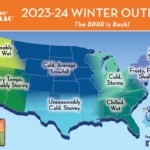



nothing SO FAR IN N. Carolina, DON’T EXOECT THEM UNTIL LATER in July or August!
Hi Carl, Thanks for sharing what’s happening in your neck of the woods. Stay in touch.
We are located between Hondo and Bandera Texas. We have both kinds of Cicadas. They have been around for three weeks.
We aren’t listed on your map.
Are they also called June bugs ?
Hi Syl, They are not the same as June bugs. June bugs are a solid green color and, to my knowledge, do not have any vocal talents like the Cicadas. I have lived in Georgia for my entire life and remember the Cicadas for the late 60s. The sound was deafening but not in a bothersome way..
Don’t see the map
I am a little skittish around bugs especially bigger ones! What counties in Alabama will be affected?
Hey Verona, It looks like most of Alabama will play host to these critters. Don’t worry about them. They are really harmless, just noisy!
Here’s a very interesting article that my sister Harriet posted to their community Facebook page recently.
I remember cicadas as a child, 1965 or 1966 when we were living in Ft. Stewart, GA for two summers, so more likely my memory was from spring-summer of 1966. More than anything, I remember their crispy empty shells clinging to the pine trees. I took a handful to school; Ms Groover was impressed. There were thousands of those on our trees, and neighbors’ trees.
2024 minus 1965 and 1966 is 59-58-years, neither an even multiple of 13y or 17y, still, I am certain of what I witnessed in one of those two years. Just a little confused over which brood they might have been.
Anyone else remember this in the SE USA one of those two years, 1965 or 1966?
(Replacing my earlier post that had incorrect years).
There can be many broods in an area – so she could be spot on with her dates!
Sidney, I also remember a major cicada emergence sometime in the late 1960’s in Ft. Thomas, KY, just across the river from Cincinnati, Ohio. I think maybe ’68 or ’69.
I love these little critters for some reason! I’m absolutely certain that the “17-year brood” was in Ft. Thomas in ‘69, ‘86, ‘03, and ‘20. If we get any this year, they’d have to be of the “13-year brood” species. Their (13s) emergences have tended to be smaller and their colors haven’t been as impressive.